Race heats up as quantum revolution awaits
Artificial intelligence has attracted widespread attention from corporate giants and political leaders around the world. Meanwhile, a fierce global race is underway with the goal of developing quantum computing, seen by many experts as the next revolutionary technology in the field.
Utilizing the principles of quantum physics, quantum computers have the potential to drive advances in a number of fields, including drug research, stock market analysis, and data encryption, and are expected to bring huge economic rewards to leading companies and countries.
In this technological race, tech giants such as Google, Microsoft, Intel and others are racing to achieve major breakthroughs in quantum computing. Recently, IBM announced at Rensselaer Polytechnic Institute (RPI) in New York that it has installed the first quantum computer on the campus, marking another advancement in quantum computing.

Thirty years ago, a demonstration by physicist Peter Shore revealed the amazing potential of quantum computing: quantum computers were able to break the encryption currently widely used on the Internet in a matter of hours, whereas it would take billions of years for a conventional computer to accomplish the same task. The discovery has sparked an intense global quest for quantum computers.
McKinsey & Co. reported last year that quantum computing is most likely to have the first economic impact in four areas: automotive, chemistry, financial services and life sciences. The report predicted that by 2035, the value of quantum computing applications in these fields could reach $1.3 trillion.
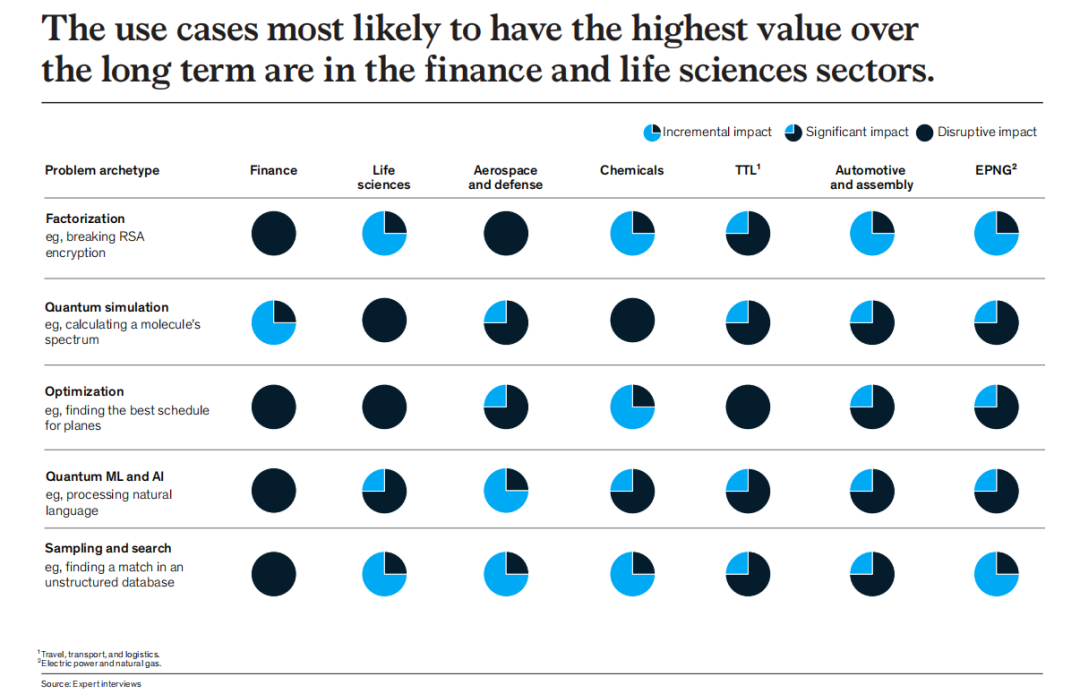

IBM and Atom Computing have successfully broken the important milestone of 1,000 quantum bits, marking a significant step forward in realizing large-scale quantum hardware. In addition, substantial progress has been made in almost all major quantum bit technologies.
Last August, scientists at the University of Chicago announced the observation of "quantum hyperchemistry," a phenomenon in which particles in the same quantum state show accelerated rates of chemical reactions.
Earlier in the same year, researchers in Sweden successfully solved a simple chemical problem by means of a quantum computer, providing a proof of concept for more advanced computation.
Prof. Séamus Davis, who won the prestigious U.S. Buckley Prize, said in an interview referring to quantum computing: "This is one of the pinnacle achievements of humanity. Although many people are not yet aware of it, it is crucial that our civilization has come to rely heavily on our understanding and control of quantum mechanics."


Recent research announced by Quantinuum and Microsoft demonstrates "the most reliable logic quantum bit in history" with an error rate of 1/800th that of a physical quantum bit, and has been tested on over 14,000 quantum bits without finding any errors. This demonstrates that error diagnosis and correction can be performed without compromising the logical quantum bit, significantly reducing the error rate to 1/1000.While this discovery is exciting, it is important to note that the paper in question has not yet been peer-reviewed.
Meanwhile, cross-quantum collaborations are developing. Microsoft has not only invested directly in Photonic Inc, a photonics technology company, but through its M12 Ventures unit, it is also a major investor in PsiQuantum, a company working to develop a general-purpose quantum computer based on silicon photonic quantum bits.
In addition to Microsoft, other companies have also made new advances in quantum computing. For example, Amazon announced that its Amazon Braket platform will integrate hybrid quantum-classical algorithms to enhance machine learning capabilities and introduce hyperparameter optimization to further extend its AWS service designed for quantum computing experiments.
In February, Canada's Nord Quantique announced a world-record extension of the coherent lifetime of a quantum bit through quantum error correction at the single quantum bit level via an efficient hardware approach.
In January, QuEra Computing announced its ambitions to develop an error-correcting quantum computer and set a timetable starting in 2024, with the goal of eventually delivering a quantum system with 100 logical error-correcting quantum bits.
In the same month, Alice & Bob - a startup based in Paris and Boston - announced a new quantum error-correction architecture. This new approach utilizes low-density parity-check codes on cat quantum bits and aims to reduce the hardware requirements for building efficient quantum computers.
In March, Google launched the XPRIZE Quantum Applications Competition, a three-year, $5 million global competition designed to spur innovation in the use of quantum computing to solve real-world problems.
However, there are growing signs that the buzz around quantum computing may have peaked. The growth of emerging startups appears to be slowing down, and caution is increasing in the global venture capital community.
According to the report, from record highs in 2021 and 2022 to 2023, investments in the quantum technology space have decreased by about 50 percent (about $1.25 billion). This downward trend is believed to be due to a shift in the focus of the VC market to rapidly evolving generative AI technologies.
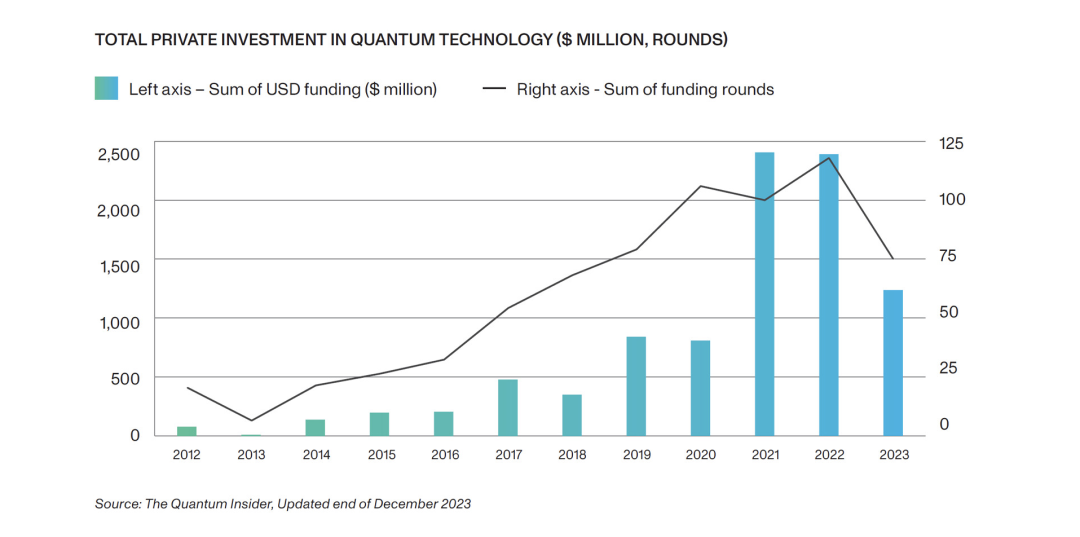
While companies like Photonic, Oxford Quantum Circuits, and Quantinuum have announced hundreds of millions of dollars in increased funding, overall more money is flowing into areas like artificial intelligence and biotechnology. The quantum industry also faces a talent shortage, exacerbating the challenge, with many companies struggling to find the physicists, quantum engineers, chip designers and computer scientists they need.
The quantum computing industry is experiencing increasing pressure on the government to mobilize its resources and demonstrate its effective steps in creating commercial value.
Daniel Lidar, a professor of engineering at the University of Southern California, goes on to state, "The government that has the first truly useful quantum computer will wield extraordinary influence. This explains why many governments are investing heavily in quantum computing and why many companies are betting billions of dollars on this technology."
Time continues to pass silently, and it is difficult to predict how fast the "pace of time" will move. Quantum computers, like conventional computers, are susceptible to internal and external noise, which can lead to reliability problems. But the challenges of quantum computers are compounded by the fact that noise can lead to decoherence of quantum bits - that is, the loss of their superposition state - making it elusive to maintain the quantum state required for computation, which may not only degrade performance, but may even destroy it altogether.
The race to achieve large-scale fault-tolerant quantum computing is more of a protracted marathon than a sprint. Prof. Lidar pointed out that although thousands of researchers around the world are dedicated to solving the many challenges facing quantum computing, it may still be 5 to 10 years before practical applications are possible.
The importance of reducing quantum computer errors is becoming widely recognized. Individual physical quantum bits are highly susceptible to decoherence from a variety of noise sources, such as temperature variations, electromagnetic interference, or mutual interference. Decoherence is disastrous for realizing quantum dominance, as the affected quantum bit will not be able to represent both 1 and 0, but will only be rendered as a classical 1 or 0.
Quantum error correction technology provides a way to overcome noise and decoherence. In short, it does so by constructing error-free logical quantum bits from a set of noise-affected physical quantum bits. To use a simple analogy, this is like decoding the original message by repeating the game of "corrupted phone" several times, and collecting enough noise information to correct the error by comparing a set of characteristics. Precise mathematical modeling of quantum error correction is still a highly active area of research, but one thing is clear: the number of logical quantum bits in a system is becoming a key metric for assessing the potential for long-term success of quantum hardware.
The fact that different quantum bit models require significantly different ratios between the physical and logical bits required is a surprising finding. One study suggests that the ratio for photonics models may be as low as 2:1, while the ratio for neutral atoms and trapped ions is closer to 10:1, and for superconducting models it may be as high as 1,000:1. This somewhat balances the competitive landscape of the quantum computing market, giving challengers like QuEra a chance to catch up with or even overtake industry giants such as IBM and Google in the race for high logical quantum bit counts In short, the shift to "logic" has been a very important one.
In short, the need to move to the "Logic Age" has become clear, and many industry leaders have emphasized this in their latest roadmaps. However, it is not enough to optimize system design to reduce errors; the impact of overall system size and power consumption on long-term success must also be considered.
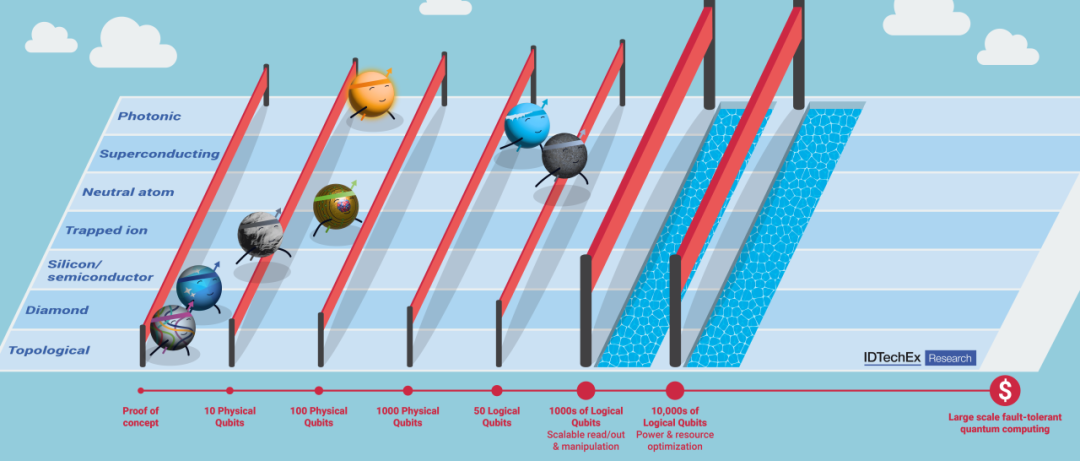
Overcoming the infrastructural challenges associated with scaling up the hardware of quantum computers will be no easy task. Currently, almost all quantum systems require cooling, whether using cryostats or laser technology. In these systems, it is often the cooling unit that takes up the most space. As the number of logic quantum bits increases, the space to accommodate them in the cooling system becomes increasingly tight.
As a result, numerous hardware development programs have turned to modular designs that link multiple systems together. While quantum computing is intended to solve high-value problems through cloud computing, and the large demand for data center space is not an absolute obstacle, in some cases the potential power requirements for large, fault-tolerant computers are on the order of megawatts, enough to make consideration of small, stand-alone modular reactors possible. In order to truly follow the classic evolutionary path of computing from vacuum tubes to smartphones, we should now proceed to reduce the size of components and then expand their functionality.
Quantum bit density - i.e. the physical size of a quantum bit - is a key factor influencing infrastructure requirements. Certain technologies claim to have a clear advantage in this area. Current estimates suggest that superconducting and photonics designs can integrate thousands of quantum bits per chip; captured-ion technologies can reach tens of thousands of quantum bits; and silicon spin technologies are expected to integrate up to billions of quantum bits. The limits of integration density depend in part on the physical size of the quantum state and the available fabrication techniques. The advantages of silicon spin technology come primarily from the semiconductor industry's highly optimized techniques for transistor and CMOS fabrication.
Microsoft is also working on the development of hardware-protected Majorana quantum bits and micron sizes, with a particular emphasis on the advantages of realizing "practical-sized single-module machines". However, there is still uncertainty about how the required spacing of quantum bits will vary between technologies, due to the effects of crosstalk and other noise sources.
In addition to the quantum bits themselves, the manipulation and readout systems are often the largest space occupants. For example, as the number of quantum bits increases from hundreds to thousands, the need for microwave wiring, interconnects and lasers may become less practical.
As a result, several teams are working on more optimized methods of manipulation and control. For example, SEEQC has developed an alternative to digital on-chip analog control for superconducting quantum bits, an approach that is gaining traction in other quantum technology systems. Similarly, Oxford Ionics has recently patented "electron quantum bit control", an on-chip interface for ion trap technology.
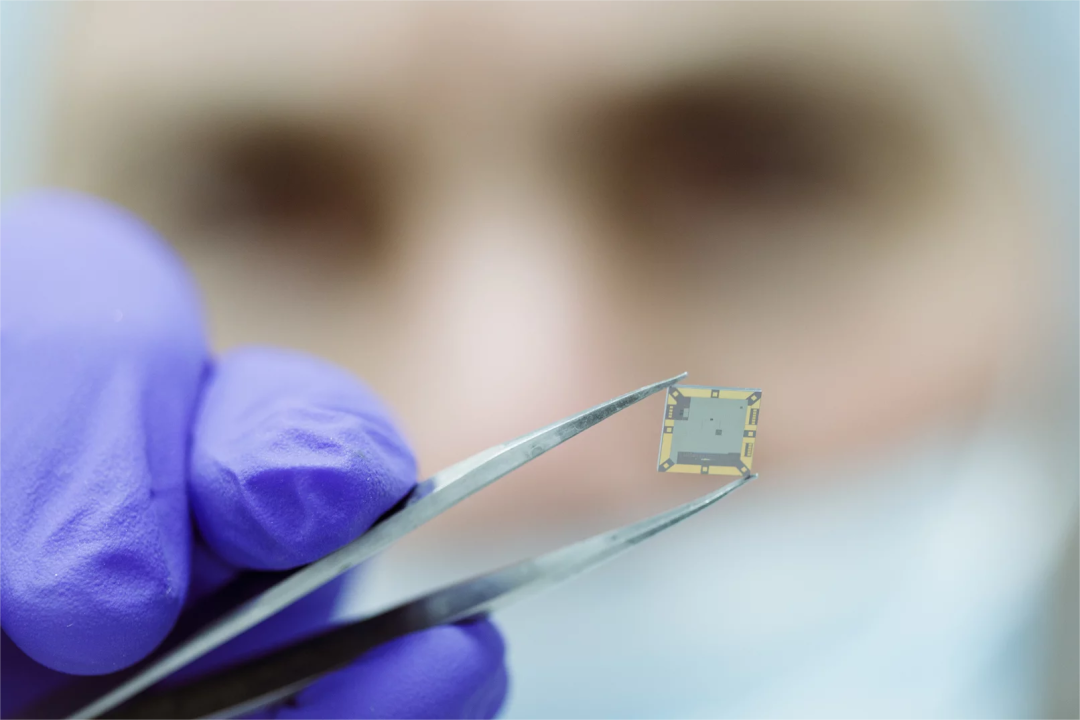
Currently, quantum computers operate primarily in specialized scientific laboratories. However, as the capabilities of quantum computers increase, there is growing interest in deploying these systems into a wider range of environments. Enterprises are considering quantum computers for real-world applications, while quantum startups are looking to deploy them in data centers, in close proximity to potential customers' existing IT facilities.
To create the specific environments required for quantum effects, very different technologies and support infrastructures from traditional computing are needed. At the same time, they need to be in close proximity to traditional systems in order to facilitate data exchange. This poses a challenge for businesses, which typically don't deploy such cutting-edge technology in commercial spaces filled with multiple customers - with the exception of the quantum computer that IBM installed on a university campus last week.
Many quantum computers rely on extreme cooling with liquid nitrogen and hydrogen-3, which are both difficult and potentially dangerous to handle and have no precedent in a data center environment. Nor are the form factors of supercooled systems suitable for standard racks; for example, Blufors' largest Kide system, which cools about 1,000 quantum bits, is nearly 3 meters tall and 2.5 meters in diameter, and requires a floor loading capacity of about 7,000 kilograms.
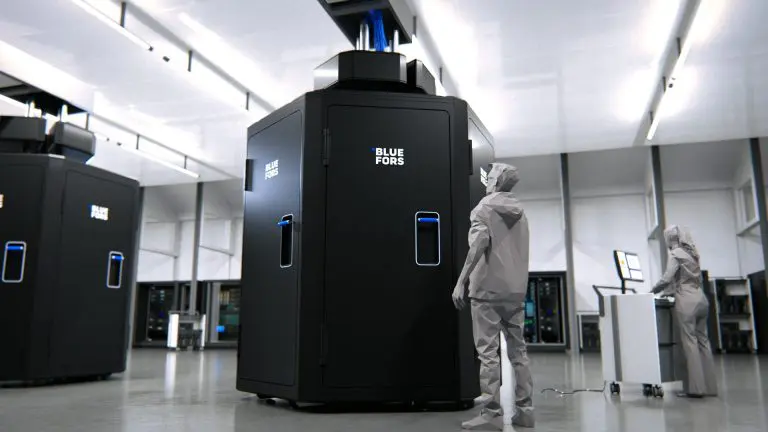
Other quantum technologies rely on high-power lasers and sensitive optical devices. While these devices are not as tall or heavy as ultracold systems, they require more space and mechanical isolation.
Change is coming. Oxford Quantum Circuits (OQC) has already deployed quantum computers in two colocation data centers, the Cyxtera facility outside London, U.K., and the Equinix facility in Tokyo, Japan.The Cyxtera deployment required adjustments to the facility's architecture, security, and operational processes.
OQC has indicated that it plans to expand its deployments further in the future, and no doubt other quantum companies will be looking to follow suit.
Currently, companies that make and sell quantum processors such as Quandela, Quantinuum, IQM and Atom Computing have very limited production runs in the single digits, while IBM is way ahead in terms of production numbers, having produced dozens of devices.
As the number of quantum bits and use cases increase, opportunities for a similar model will emerge for colocation/wholesale providers, although quantum computers will need to meet the requirements of high-density AI, but will also need unique "accommodations," often in the same building.
Quantum computing providers offer access to their in-house lab quantum computers through cloud services, but as demand increases and these companies begin to build more systems, more dedicated space may be required.
In this competitive industry, the next few years will determine which strategy is most likely to achieve lasting quantum commercial advantage, with tasks involving reducing errors, increasing the number of logical quantum bits while optimizing resource efficiency, and considering critical factors such as gate speed and algorithm development. Given the complexity of this task, many companies may struggle to survive this decade.
Despite the difficulties, the world-changing potential of quantum computing in areas such as finance, healthcare, sustainability and security remains a target for countries and companies to race to.
Reference links :
[1]https://abcnews.go.com/Business/after-ai-watershed-technology-quantum-computing/story?id=108843842
[2]https://newsroom.ibm.com/2024-04-05-Rensselaer-Polytechnic-Institute-and-IBM-unveil-the-worlds-first-IBM-Quantum-System-One-on-a-university-campus
[3]https://www.mckinsey.com/capabilities/mckinsey-digital/our-insights/quantum-technology-sees-record-investments-progress-on-talent-gap
[4]https://www.eetimes.eu/quantum-computing-the-logical-next-steps/
[5]https://thequantuminsider.com/2023/03/16/seeqc-unveils-first-fully-digital-chips-for-full-stack-quantum-computers/
[6]https://www.siliconrepublic.com/innovation/microsoft-quantinuum-quantum-computer-qubits-reliable-breakthrough
[7]https://www.networkworld.com/article/2080843/microsoft-claims-quantum-computing-breakthrough-customers-to-benefit-soon.html
[8]https://www.networkworld.com/article/1303457/generative-ai-hype-dampens-vc-funding-for-quantum-computing.html
[9]https://www.meetiqm.com/newsroom/press-releases/state-of-quantum-report-2024
[10]https://scottaaronson.blog/
[11]https://www.datacenterdynamics.com/en/opinions/its-time-for-colos-and-wholesalers-to-start-looking-at-quantum-computing-customers/






